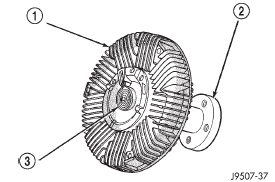 Jeep Cherokee Service ManualCooling system » Description and operation
Jeep Cherokee Service ManualCooling system » Description and operation
Viscous fan drive
Viscous fan drive
DESCRIPTION
CAUTION: Engines equipped with poly-V drive belts have reverse rotating fans and viscous fan drives. They are marked with the word REVERSE to designate their usage. Installation of the wrong fan or viscous fan drive can result in engine overheating.
The thermal viscous fan drive is a silicone-fluidfilled coupling used to connect the fan blades to either the engine or the water pump shaft. The coupling allows the fan to be driven in a normal manner.
This is done at low engine speeds while limiting the top speed of the fan to a predetermined maximum level at higher engine speeds.
2.5L vehicles with A/C are equipped with a viscous fan drive which is designed to "free wheel" during most of the ambient conditions encountered by the vehicle and will only engage during high heat loads as seen in trailer towing or high ambient temperatures.
A thermostatic bimetallic spring coil is located on the front face of the viscous fan drive unit. A typical viscous unit is shown in (Fig. 13). This spring coil reacts to the temperature of the radiator discharge air. It engages the viscous fan drive for higher fan speed if the air temperature from the radiator rises above a certain point. Until additional engine cooling is necessary, the fan will remain at a reduced rpm regardless of engine speed.
Vehicles equipped with 2.5L engines have what is know as an hybrid cooling fan system. This means that not only do they have a viscous fan but they also have an electric fan as well. The hybrid viscous fan drive has a low speed characteristic. This causes the mechanical fan speeds to be very low 200-400 rpm range when not engaged allowing the engine to have additional performance and horsepower gaines.

Fig. 13 Typical Viscous Fan Drive
1 - VISCOUS FAN DRIVE
2 - MOUNTING HUB
3 - THERMOSTATIC SPRING
OPERATION
Only when sufficient heat is present, will the viscous fan drive engage. This is when the air flowing through the radiator core causes a reaction to the bimetallic coil. It then increases fan speed to provide the necessary additional engine cooling.
Once the engine has cooled, the radiator discharge temperature will drop. The bimetallic coil again reacts and the fan speed is reduced to the previous disengaged speed.
Cooling system
Automatic transmission oil cooler
Coolant reserve/overflow system
Cooling system fans
Block heater
Thermostat
Radiator
Radiator pressure cap
Water pump
Hose clamps
Viscous fan drive
Electric cooling fan
Jeep Cherokee Service Manual
- Lubrication and maintenance
- Suspension
- Differential and driveline
- Brakes
- Clutch
- Cooling system
- Battery
- Starting systems
- Charging system
- Ignition system
- Instrument panel systems
- Audio systems
- Horn systems
- Speed control system
- Turn signal and hazard warning systems
- Wiper and washer systems
- Lamps
- Passive restraint systems
- Electrically heated systems
- Power distribution systems
- Power lock systems
- Vehicle theft/security systems
- Power seat systems
- Power window systems
- Power mirror systems
- Chime/buzzer warning systems
- Overhead console systems
- Engine
- Exhaust system
- Frame and bumpers
- Frame
- Fuel system
- Steering
- Transmission and transfer case
- Tires and wheels
- Body
